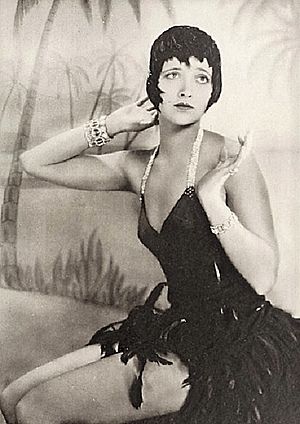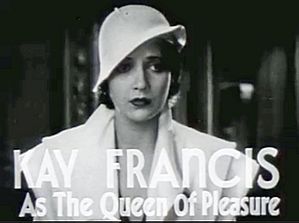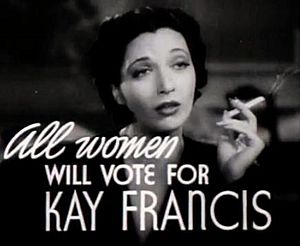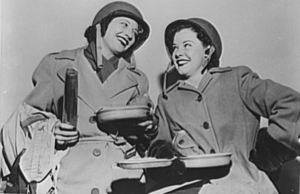Kay Francis facts for kids
Quick facts for kids
Kay Francis
|
|
|---|---|
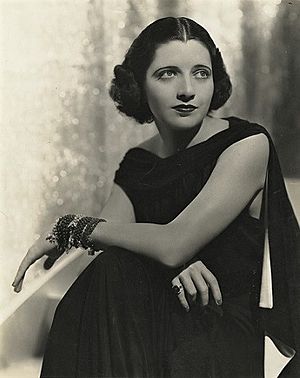
Francis in 1935
|
|
| Born |
Katharine Edwina Gibbs
January 13, 1905 Oklahoma City,
Oklahoma Territory, U.S. |
| Died | August 26, 1968 (aged 63) New York City, U.S.
|
| Occupation | Actress |
| Years active | 1925–1951 |
| Spouse(s) |
James Dwight Francis
(m. 1922; div. 1925)William Gaston
(m. 1925; div. 1927)Kenneth MacKenna
(m. 1931; div. 1934) |
Kay Francis (born Katharine Edwina Gibbs; January 13, 1905 – August 26, 1968) was a famous American actress. She starred in plays on Broadway and later became a big movie star. From 1930 to 1936, she was one of the most popular and highest-paid actresses at Warner Bros. studio. She used her mother's maiden name, Francis, as her stage name.
Contents
Early Life and Education
Katharine Edwina Gibbs was born in Oklahoma City, Oklahoma Territory (now Oklahoma), in 1905. She was the only child of Joseph Sprague Gibbs and Katharine Clinton. Her mother, Katharine Clinton, was also an actress.
Kay often traveled with her mother because of her mother's acting career. She went to Catholic schools when her family could afford it. At age five, she became a student at the Institute of the Holy Angels. She also attended Miss Fuller's School for Young Ladies and the Cathedral School. Later, she enrolled at the Katharine Gibbs Secretarial School in New York City.
In 1922, when Kay was 17, she married James Dwight Francis. Their marriage ended in divorce three years later.
Starting Her Acting Career
In 1925, Kay Francis went to Paris. While there, she met and secretly married Bill Gaston in October 1925. This marriage was also short-lived. Kay decided to follow her mother's path and become an actress.
Broadway Debut
Kay made her first appearance on Broadway in November 1925. She played the Player Queen in a modern version of Shakespeare's Hamlet. She later said she got the part by "lying a lot, to the right people." One of these people was producer Stuart Walker. He hired her for his Portmanteau Theatre Company.
She traveled between Dayton, Ohio, Cincinnati, Ohio, and Indianapolis, Indiana. She played many different roles, from secretaries to small parts. In February 1927, Francis returned to New York. She got a part in the Broadway play Crime. A young Sylvia Sidney was the main actress, but she later said Francis stole the show.
After her divorce from Gaston in September 1927, she promised to stop acting. However, this promise only lasted a few months. She soon appeared in a play called Venus, where she played an aviator.
Moving to Hollywood
Francis appeared in only one more Broadway show, Elmer the Great, in 1928. This play did not do well. Even though she was broke, Francis was determined to succeed on her own.
Actor Walter Huston was impressed by her acting. He encouraged her to try out for his new studio, Paramount Pictures. Paramount offered her a contract for $300 a week. Francis made two films in New York: Gentlemen of the Press (1929) and the Marx Brothers film The Cocoanuts (1929). After these films, she moved to Hollywood.
Film Career Success
Many major film studios had moved from New York to California. When sound pictures became popular, more Broadway actors came to Hollywood. These included Ann Harding, Barbara Stanwyck, Humphrey Bogart, and James Cagney.
Kay Francis signed a contract with Paramount Pictures. She quickly made a strong impression. She often starred with William Powell. Their first film together was Street of Chance (1930). They worked well together and made 21 films between 1930 and 1932.
Francis's career grew at Paramount. She had a slight speech difference where she pronounced "r" like "w". This led to the nickname "Wavishing Kay Fwancis." She appeared in films like Girls About Town (1931) and 24 Hours (1931). In December 1931, Francis helped open the new art deco Paramount Theatre in Oakland, California.
Becoming a Star at Warner Bros.
In 1932, Francis's career changed. Warner Bros. offered her a better salary of $4,000 a week and promised her lead roles. Paramount sued Warner Bros. over this. Warner Bros. convinced both Francis and Powell to join their studio.
After playing some villain roles, Francis started getting more sympathetic characters. For example, in The False Madonna, she played a woman who learns about family values. After she became a big star at Warner Bros., she was loaned back to Paramount for Ernst Lubitsch's Trouble in Paradise (1932).
Mainstream Successes
From 1932 to 1936, Kay Francis was the top female star at Warner Bros. Her films were often made to highlight her talent. By 1935, she was one of the highest-paid actors, earning $115,000 a year. This was much more than other stars like Bette Davis. From 1930 to 1937, Francis appeared on the covers of 38 film magazines. Only child star Shirley Temple appeared on more.
Soon after arriving in Hollywood, she married actor and producer Kenneth MacKenna in January 1931. They separated in 1933 and divorced in 1934.
Francis often played strong, suffering heroines. Her films included I Found Stella Parish and Secrets of an Actress. She was known for wearing beautiful and expensive clothes in her movies. Sometimes, her costumes were more famous than the characters she played. In Give Me Your Heart (1936), her acting was praised by The New York Times.
Francis became unhappy with the types of films she was making. She felt Warner Bros. focused too much on lavish costumes and not enough on good stories. She even threatened to sue the studio. This led to her getting smaller roles in less important films. In 1939, her contract with Warner Bros. ended.
Later Career and World War II
In May 1938, a group of theater owners listed Francis as "box office poison" in an advertisement. This meant they thought her films were not making enough money. After leaving Warner Bros., she struggled to get another studio contract.
However, actress Carole Lombard insisted that Francis be cast in her film In Name Only (1939). Francis had a supporting role in this film, which allowed her to show her serious acting skills. After this, she took supporting roles in other movies. She often played professional women or mothers.
Francis had one lead role in the gangster film King of the Underworld (1939). She played a doctor who gets involved with a gangster.
When World War II began, Francis volunteered for the war effort. She worked with the Naval Aid Auxiliary and led its Hospital Unit. She also toured war zones to entertain soldiers. Her experiences were written about in the book "Four Jills in a Jeep" by fellow volunteer Carole Landis. This book was made into a popular 1944 film, Four Jills in a Jeep. Francis, Landis, Martha Raye, and Mitzi Mayfair played themselves in the movie.
After the war, Francis found it hard to get acting jobs in Hollywood. She signed a contract for three films with a smaller studio, Monogram Pictures. These films, Divorce, Wife Wanted, and Allotment Wives, were released in 1945 and 1946.
Francis spent the rest of the 1940s acting on stage. She had success in the play State of the Union. In 1948, she had an accident during a tour in Ohio. She was badly burned by a radiator. After this, her health declined, and she retired from acting and public life.
Personal Life and Legacy
Kay Francis was married three times. Her husbands were James Dwight Francis (1922–1925), William Gaston (1925–1927), and Kenneth MacKenna (1931–1934).
In 1966, Francis was diagnosed with breast cancer. She passed away in 1968 at the age of 63. She wanted to be forgotten and asked for no funeral services or grave marker. Her body was cremated.
Kay Francis had no close living family members. She left over $1 million to The Seeing Eye. This organization in New Jersey trains guide dogs to help blind people.
Filmography
Features
| Year | Title | Role | Notes |
|---|---|---|---|
| 1929 | Gentlemen of the Press | Myra May | |
| 1929 | The Cocoanuts | Penelope | |
| 1929 | Dangerous Curves | Zara Flynn | |
| 1929 | Illusion | Zelda Paxton | |
| 1929 | The Marriage Playground | Lady Wrench | |
| 1930 | Behind the Make-Up | Kitty Parker | |
| 1930 | Street of Chance | Alma Marsden | |
| 1930 | Paramount on Parade | Carmen | Episode: "The Toreador" |
| 1930 | A Notorious Affair | Countess Olga Balakireff | |
| 1930 | For the Defense | Irene Manners | |
| 1930 | Raffles | Gwen | |
| 1930 | Let's Go Native | Constance Cook | |
| 1930 | The Virtuous Sin | Marya Ivanova Sablin | |
| 1930 | Passion Flower | Dulce Morado | |
| 1930 | Paramount on Parade | Herself | |
| 1931 | Scandal Sheet | Edith Flint | |
| 1931 | Ladies' Man | Norma Page | |
| 1931 | The Vice Squad | Alice Morrison | |
| 1931 | Transgression | Elsie Maury | |
| 1931 | Guilty Hands | Marjorie West | |
| 1931 | 24 Hours | Fanny Towner | |
| 1931 | Girls About Town | Wanda Howard | |
| 1931 | The False Madonna | Tina | |
| 1932 | Strangers in Love | Diana Merrow | |
| 1932 | Man Wanted | Lois Ames | |
| 1932 | Street of Women | Natalie 'Nat' Upton | |
| 1932 | Jewel Robbery | Baroness Teri | |
| 1932 | One Way Passage | Joan Ames | |
| 1932 | Trouble in Paradise | Madame Mariette Colet | |
| 1932 | Cynara | Clemency Warlock | |
| 1933 | The Keyhole | Anne Vallee Brooks | |
| 1933 | Storm at Daybreak | Irina Radovic | |
| 1933 | Mary Stevens, M.D. | Mary Stevens | |
| 1933 | I Loved a Woman | Laura McDonald | |
| 1933 | The House on 56th Street | Peggy Martin | |
| 1934 | Mandalay | Tanya Borodoff / Spot White / Marjorie Lang | |
| 1934 | Wonder Bar | Liane | |
| 1934 | Dr. Monica | Dr. Monica | |
| 1934 | British Agent | Elena Moura | |
| 1935 | Living on Velvet | Amy Prentiss | |
| 1935 | Stranded | Lynn Palmer | |
| 1935 | The Goose and the Gander | Georgiana | |
| 1935 | I Found Stella Parish | Stella Parish | |
| 1936 | The White Angel | Florence 'Flo' Nightingale | |
| 1936 | Give Me Your Heart | Belinda Warren | |
| 1937 | Stolen Holiday | Nicole Picot | |
| 1937 | Another Dawn | Julia Ashton Wister | |
| 1937 | Confession | Vera Kowalska | |
| 1937 | First Lady | Lucy Chase Wayne | |
| 1938 | Women Are Like That | Claire Landin | |
| 1938 | My Bill | Mary Colbrook | |
| 1938 | Secrets of an Actress | Fay Carter | |
| 1938 | Comet Over Broadway | Eve Appleton | |
| 1939 | King of the Underworld | Carol Nelson | |
| 1939 | Women in the Wind | Janet Steele | |
| 1939 | In Name Only | Maida Walker | |
| 1940 | It's a Date | Georgia Drake | |
| 1940 | When the Daltons Rode | Julie King | |
| 1940 | Little Men | Jo | |
| 1941 | Play Girl | Grace Herbert | |
| 1941 | The Man Who Lost Himself | Adrienne Scott | |
| 1941 | Charley's Aunt | Donna Lucia d'Alvadorez | |
| 1941 | The Feminine Touch | Nellie Woods | |
| 1942 | Always in My Heart | Marjorie Scott | |
| 1942 | Between Us Girls | Christine 'Chris' Bishop | |
| 1944 | Four Jills in a Jeep | Herself | |
| 1945 | Divorce | Dianne Carter | |
| 1945 | Allotment Wives | Sheila Seymour | |
| 1946 | Wife Wanted | Carole Raymond | (final film role) |
Short subjects
- Screen Snapshots Series 16, No. 3 (1936) as Herself – Observer
- Show Business at War (1943, Documentary) as Herself (uncredited)
See also
 In Spanish: Kay Francis para niños
In Spanish: Kay Francis para niños


